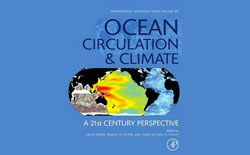Book on Ocean Circulation and Climate published

Ocean Circulation and Climate – A 21st Century Perspective
Edited by Siedler, Griffies, Gould, and Church
Published December 2013
The ocean is one of the most important components of the climate system. It contributes large reservoirs for heat and carbon and is thus a major player in controlling climate change.
“Ocean Circulation and Climate – A 21st Century Perspective” is the second edition of a highly successful book on the circulation of water masses in the ocean and the role of the ocean in the climate system, published in 2001 at the end of WOCE. The current state of knowledge is summarized in this new book, written by 76 authors from 15 countries.
Two developments in particular provided new knowledge on the oceanic circulation. First there has been a most remarkable progress in ocean observations, with a transition from special experiments to long-term monitoring. The program ARGO with more than 3000 profiling drifters now provides physical data from the ocean’s interior with global coverage. Also, the potential of satellite observations is used extensively to observe distributions of temperature, plankton, currents and other properties.
The second cause is the rapid progress in the modeling of ocean, sea ice and atmosphere. This is based both on the speedy development of computer systems and the close collaboration of modeling groups in the leading research centers, with the mutual exchange of model codes and joint interpretation.
The introduction of the book summarizes the role of ocean in the present climate system and in the earlier paleoclimate state. After a discussion of current observational methods, new results are given on physical processes in the ocean. This leads to an extensive presentation of the present knowledge on the large-scale ocean circulation and water mass distributions. Because of the increasing importance of models for the understanding and prediction of ocean and climate change, a large part of the book deals with modeling and the results on long-term changes. The discussion is completed by new developments in biogeochemical processes, in the carbon cycle, and in marine ecosystems.













